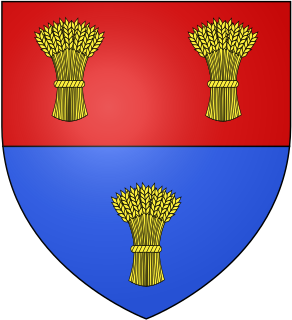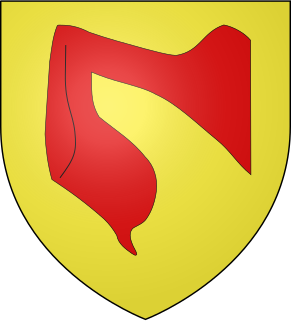William of Hereford, Baron Abergavenny was a holder of the feudal lordship of Abergavenny in the Welsh Marches in the mid twelfth century.
William of Hereford was a son of Miles of Gloucester, 1st Earl of Hereford and his wife Sybil de Neufmarche, daughter of Bernard de Neufmarché of Brecon.
His brothers were Mahel of Hereford and Walter of Hereford.
He was made King's Constable of the region and succeeded to the title of Baron Abergavenny about 1164.
William of Hereford died as a result of injuries sustained from falling masonry during a fire at Bronllys Castle near modern Talgarth, Powys in 1166. He died without issue.

Abergavenny is both a market town and a community in Monmouthshire, Wales. Abergavenny is promoted as a Gateway to Wales; it is approximately 6 miles (10 km) from the border with England and is located where the A40 trunk road and the A465 Heads of the Valleys road meet.

William de Braose, 3rd Lord of Bramber was a 12th-century Marcher lord who secured a foundation for the dominant position later held by the Braose family in the Welsh Marches. In addition to the family's English holdings in Sussex and Devon, William had inherited Radnor and Builth, in Wales, from his father Philip. By his marriage he increased the Braose Welsh holdings to include Brecon and Abergavenny.

William de Braose,, 4th Lord of Bramber, court favourite of King John of England, at the peak of his power, was also Lord of Gower, Abergavenny, Brecknock, Builth, Radnor, Kington, Limerick, Glamorgan, Skenfrith, Briouze in Normandy, Grosmont, and White Castle.
The title Baron Bergavenny was created several times in the Peerage of England and once in the Peerage of Great Britain, all but the first being baronies created by error. Abergavenny is a market town in South East Wales with a castle established by the Norman lord Hamelin de Balun c. 1087.

William III de Cantilupe was the 3rd feudal baron of Eaton Bray in Bedfordshire, and jure uxoris was feudal baron of Totnes in Devon and Lord of Abergavenny. His chief residences were at Calne in Wiltshire and Aston Cantlow, in Warwickshire, until he inherited Abergavenny Castle and the other estates of that lordship.

Miles FitzWalter of Gloucester, 1st Earl of Hereford was a great magnate based in the west of England. He was hereditary Constable of England and Sheriff of Gloucestershire.

Aston Cantlow is a village in Warwickshire, England, on the River Alne 5 miles (8.0 km) north-west of Stratford and 2 miles (3.2 km) north-west of Wilmcote, close to Little Alne, Shelfield, and Newnham. It was the home of Mary Arden, Shakespeare's mother. At the 2001 census, it had a population of 1,674, being measured again as 437 at the 2011 Census.

Henry de Hastings of Ashill, Norfolk, was a supporter of Simon de Montfort in his rebellion against King Henry III. He led the Londoners at the Battle of Lewes in 1264, where he was taken prisoner, and fought at the Battle of Evesham in 1265, where de Montfort was killed. He resisted King Henry III at Kenilworth and after the Dictum of Kenilworth he commanded the last remnants of the baronial party when they made their last stand in the Isle of Ely, but submitted to the king in July 1267. In 1264 he was created a supposed baron by de Montfort, which title had no legal validity following the suppression of the revolt.

William de Beauchamp, 1st Baron Bergavenny, KG was an English peer.

Bernard de Neufmarché, also Bernard of Newmarket or Bernard of Newmarch was the first of the Norman conquerors of Wales. He was a minor Norman lord who rose to power in the Welsh Marches before successfully undertaking the invasion and conquest of the Kingdom of Brycheiniog between 1088 and 1095. Out of the ruins of the Welsh kingdom he created the Anglo-Norman lordship of Brecon.

Hamelin de Ballon was an early Norman Baron and the first Baron Abergavenny and Lord of Over Gwent and Abergavenny; he also served William Rufus.
Henry FitzMiles, Baron Abergavenny was a Norman baron and a Marcher Lord in the Welsh Marches.
Roger Fitzmiles, 2nd Earl of Hereford, was an English noble who played an active and influential part in the wars between Empress Matilda and King Stephen.
Walter of Hereford was a holder of the feudal title Baron Bergavenny or Lord Abergavenny in the Welsh Marches in the mid twelfth century.
Mahel of Hereford was a holder of the feudal lordships of Brecon and Abergavenny in the Welsh Marches in the mid 12th century.
Bertha of Hereford, also known as Bertha de Pitres, was the daughter of Miles de Gloucester, 1st Earl of Hereford, and a wealthy heiress, Sibyl de Neufmarché. She was the wife of William de Braose, 3rd Lord of Bramber to whom she brought many castles and Lordships, such as Brecknock, and Abergavenny.
Humphrey III de Bohun of Trowbridge Castle in Wiltshire and of Caldicot Castle in south-east Wales, 5th feudal baron of Trowbridge, was an Anglo-Norman nobleman and general who served King Henry II as Lord High Constable of England.
Sibyl de Neufmarché, Countess of Hereford, suo jure Lady of Brecknock, was a Cambro-Norman noblewoman, heiress to one of the most substantial fiefs in the Welsh Marches. The great-granddaughter of Gruffydd ap Llywelyn, king of Wales, Sibyl was also connected to the nobility of England and Normandy. Sibyl inherited the titles and lands of her father, Bernard de Neufmarché, Lord of Brecon, after her mother, Nest ferch Osbern, had declared her brother Mahel to have been illegitimate. Most of these estates passed to Sibyl's husband, Miles de Gloucester, 1st Earl of Hereford, as her dowry. Their marriage had been arranged personally by King Henry I of England in the spring of 1121. Sibyl, with her extensive lands, was central to the King's plans of consolidating Anglo-Norman power in south-east Wales by the merging of her estates with those of Miles, his loyal subject on whom he relied to implement Crown policy.

The House of Braose was a prominent family of Anglo-Norman nobles originating in Briouze, near Argentan, Orne, Normandy. Members of this family played a significant part in the Norman conquest of England and subsequent power struggles in England, Wales and Ireland in the 11th to 14th centuries.
Margaret of Hereford was an English noblewoman and the eldest daughter of Miles de Gloucester, 1st Earl of Hereford by his wife, the wealthy Cambro-Norman heiress Sibyl de Neufmarché. Margaret married Humphrey II de Bohun, by whom she had five children. Margaret held the office of Constable of England and as a widow, exercised lordship of Herefordshire until her own death. She was the benefactress of several religious institutions.